

In dev blog #4, we will look at additional arms and armors of the Korean peninsula that will be recreated in the mod.
Before you read, you please note:
The names in this dev blog are structured as [Last name, First name] in accordance to the traditional Korean method.
When new Korean terms are introduced, every beginning of a syllable is capitalized. This is repeated once or twice then the normal English grammer scheme is adhered.
The Romanization of Korean did not follow the academic method, but tried to make the sounds as close as possible.
The measurments of length may be inaccurate, as units have constantly changed through time.
Let's get started!
01.ShinGiJun, Hwacha
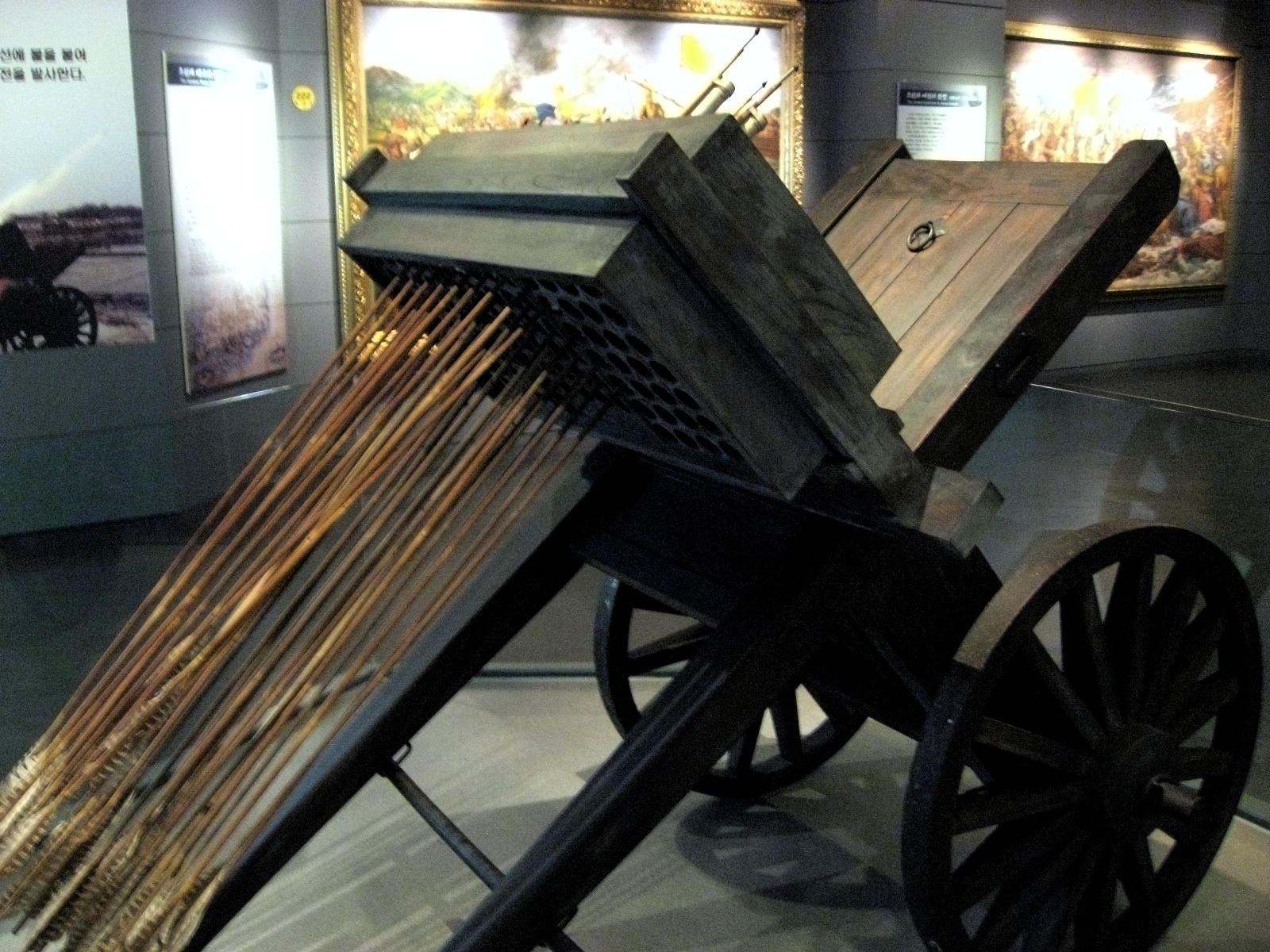

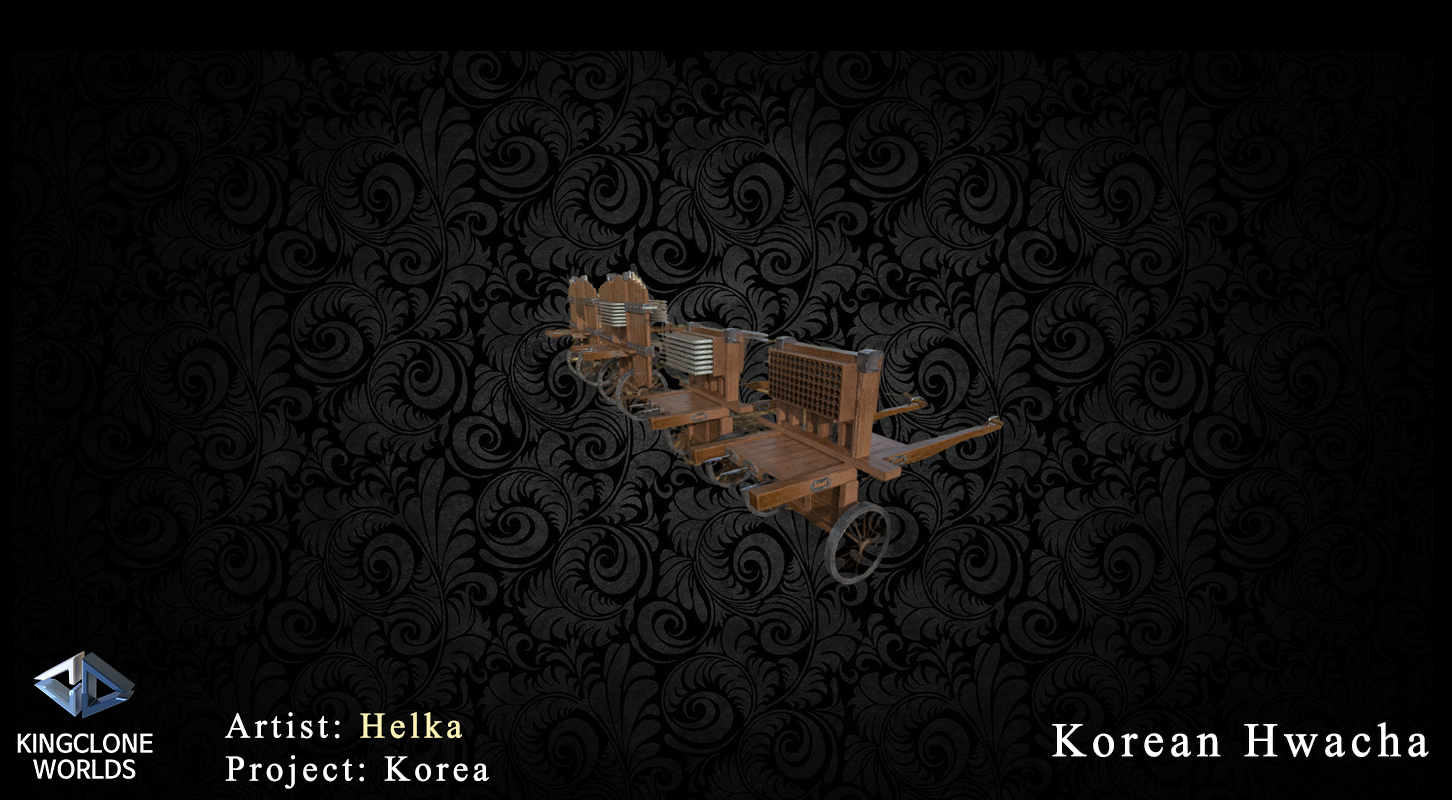
ShinGiJun [Spirit-Machine Arrow/Gunpowder propelled arrows] & Hwacha[Fire Carriage]
MyungJong era Hwacha as seen in the mod
▼ Celebrating the defeat of Japanese naval forces in Jinpo at 1380 by Choi MuSun
- Choi is credited to be the first to officially use gunpowder offensively during the Goryeo dynasty -
님의 재략이 때 맞추어 태어나니
His tactical skill birthed at a fateful time
30년 왜란이 하루 만에 평정되도다
30 years of Japanese disturbance put to peace on a single day
바람실은 전선은 새들도 못 따라가고
Warships taking wind outrun seabirds
화차(火車)는 우레소리를 울리며 진(陣)을 독촉하네
Thunderous Hwacha drum our lines forward
주유(周瑜)가 갈대 숲에 불 놓은 것이야 우스갯거리일 뿐이고
Zhōuyú putting the reeds to flame is put to shame
한신(韓信)이 배다리 만들어 건넜다는 이야기야 자랑거리나 될까 보냐.
Hánxìn's bridge of boats is nothing to show off about.
이제 공의 업적은 만세에 전해지고
Now Choi's deeds will be known to the times
능연각(凌煙閣)에 초상화 걸려 공경 가운데 으뜸일세
His portrait will center among our heros
공의 화약무기 제조는 하늘의 도움이니
Choi's firearm development is a blessing of the sky
한번 바다 싸움에 흉포한 무리 쓸어버리네
and removes ravenous pirates in a single battle
하늘에 뻗치던 도적의 기세 연기와 함께 사라지고
their high moral disappears with gunpowder smoke
세상을 덮은 공과 이름은 해와 더불어 영원하리
Choi's name and deeds will last as the sun
긴 맹세가 어찌 긴 세월 후에까지 기다릴까
Vows need not wait to become realized
응당 군사의 대권을 맡게 되도다
and he is rightfully given high command of our martial forces
종묘사직은 경사롭고 나라는 안정을 찾았으니
the courts are celebrating and the land is at peace
억만 백성의 목숨이 다시 소생하는도다.
lives of billions are revived once more.
『권근, 양촌집(陽村集)』 권 4, 「하최원수파진포왜선(賀崔元帥破鎭浦倭船)」
-Kwon Gun, YangChonJip[Collection of forces of light] book 4, HaChaeWonSuPaJinPoWaeSun[Marshal Choi breaks Japanese ships]-
Disclaimer: The sentiments represented in this poem are those of Kwon Gun of the Goryeo dynasty and do not represent the opinions of the modding team.
Year 1451(MunJong 1) shows a section of Hwacha(火車) developed by MunJong. During MunJong's rule, the Hwacha carried either powder propelled arrows or cannons(銃筒機).
According to [Five National Forms and Traditions]'s ByungGiDoSul(兵器圖說)[Weapons Illustrated], a ShinGiJun(Powder propelled arrows) would have a length of 229.9mm, and be inserted in a square wooded barrel with a width and thickness of 55.2mm and a circular hole(圓孔木桶) 46.0mm wide with 7 stacks totaling a 100 arrows, complete with a wooden carapace.
The lowermost stack held 10 arrows, while stacks 2 to 7 held 15 arrows each totaling a 100 arrows. This wooden armament would be approximately 1149.4mm in length and 398.5mm in height.
The firing angle would be adjusted using the carriage, and a singular fuse would be lit to fire arrows of each stack beginning with the topmost stack, firing 15 arrows at once and a 100 arrows in total. The construction manual for this armament is one of the oldest in existence.
- Encyclopedia of Korean National Culture(ShinGiJunGi(神機箭機/Book on Powder propelled arrows) Choi YunSuk, written 1995)
- [Five National Forms and Traditions]
- 『Studies on Initial forms of Korean Gunpowder weapons(韓國初期火器硏究)』(Choi YunSuk,IlJiSa,1981)
High ranking military officials such as the YiJungBu Marshal(兵曹堂上), Commander of 3 armies(三軍都鎭撫), and Military Technology Administrator(軍器監提調) assemble at the MoHwaGwan(慕華館/Garden to admire flowers) and observe the firing of Hwacha(火車) and after discussion with technological developer(提調) Lee Sa-Im and other court officials suggest,
"The gunpowder arrows are efficient and beneficial, but how about we add shielding plates on the side to protect the artillerymen and line the shelves and firing holes of the ShinGiJun with iron to prevent fires?"
and the King instructed technological developer(提調) Lee Sa-Im to do as suggested.
MunJongSilOk 6, MunJong year 1 February 20th, a discussion on the construction of Hwacha
02.Ok-ro-rip
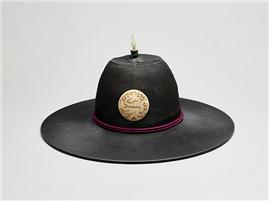
OkLo-Lyip, Jade Heron Hat
An OkLo-Lyip(玉鷺笠) indicates a form of gat with a jade decoration in the form of an egret on the top.
During the Chosun period the egret decoration on top of the ok lo-lip varied in form and material depending on the government and social ranking, and high ranking ministers on diplomatic or ceremonial missions were known to decorate their huklips(dark gat) with silver or golden egret decorations.
- Korean Cultural Foundation, GatIl by Chung ChunMo
DonNyung-Bu(Royal Famliy administrator) Hong NakSung(洪樂性) and Judge of Familial Affairs Yi BokWon(李福源) and Kim Ik(金熤) said to the King,
"We have created the royal jade heron decoration(玉鷺註) according to tradition.
The jade heron decorations of military and government officials should be decided if they should be removed or preserved." and the King replied, "What are your opinions?"
and Central Minister Jung JonGyum said, "Jade heron decorations are no different than gold and jade(金玉) hatstrings(貫子). Either for lip(hats笠) or junlip(martial hats戰笠) a specific policy would not be necessary."
ByungOIlGi(Writings of Year ByungO) Year 1786(year 10 of JungJo), May 27th
03.Jong-rip
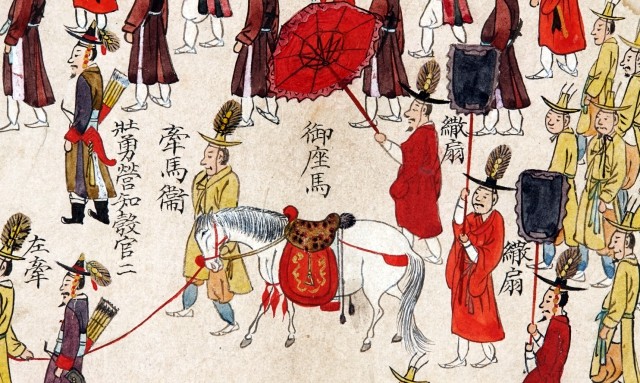


JongLyip, Horse Mane Hat
SaBokSi JeJo(Animal Husbandry Administrator/司僕寺提調) Yun Ho(尹壕) pled to the King,
"The People are in want of JongLyip(Horse Mane Hats/鬃笠) and are taking horse Mane hairs(馬鬃) from both public and private horses(公私), I pled to legislate(法) to ban this action."
Thus the King directed the Royal Famliy administrator(領敦寧) Yi Sang to begin a discussion about this matter. Jung ChangSon(鄭昌孫) suggested,
"Horse hair caps(鬃帽) should rightfully be banned, and Horse Mane hats(鬃笠) are already in the DaeJun(GyungGukDaeJun/Encyclopedia of Laws on Ruling/經國大典). However theft of horse Mane are very common, and I implore you to put a stop to this action."
Sim Hwae(沈澮) suggested,
"Horse hair caps(鬃帽) and Horse Mane hats(鬃笠) will not easily become banned by legislation, I implore you to take no action."
Yun PilSang(尹弼商) suggests,
"Horse hair caps(鬃帽) and Horse Mane hats(鬃笠) should be banned without regard of societal position and rank to prevent this momentary disregard of societal order."
No SaShin(盧思愼) suggests,"The rules of the DaeJun(大典) should not be broken just because people are thieving horse Mane hairs,"
and continues,
"we should allow Horse hair caps(鬃帽) for 1poom(品/Rank of Government official) and allow Horse Mane hats(鬃笠) according to the DaeJun without restriction based on rank."
SungJongSilOk book 188, SungJong Year 17 February 3rd, Discussion on Horse Mane hats(鬃笠) and decision to allow Horse Mane hats for all ranks
04. HukLyip or Heug-rip or Gat
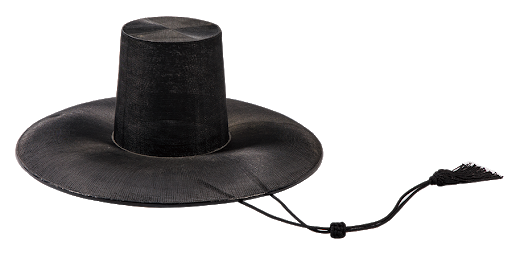
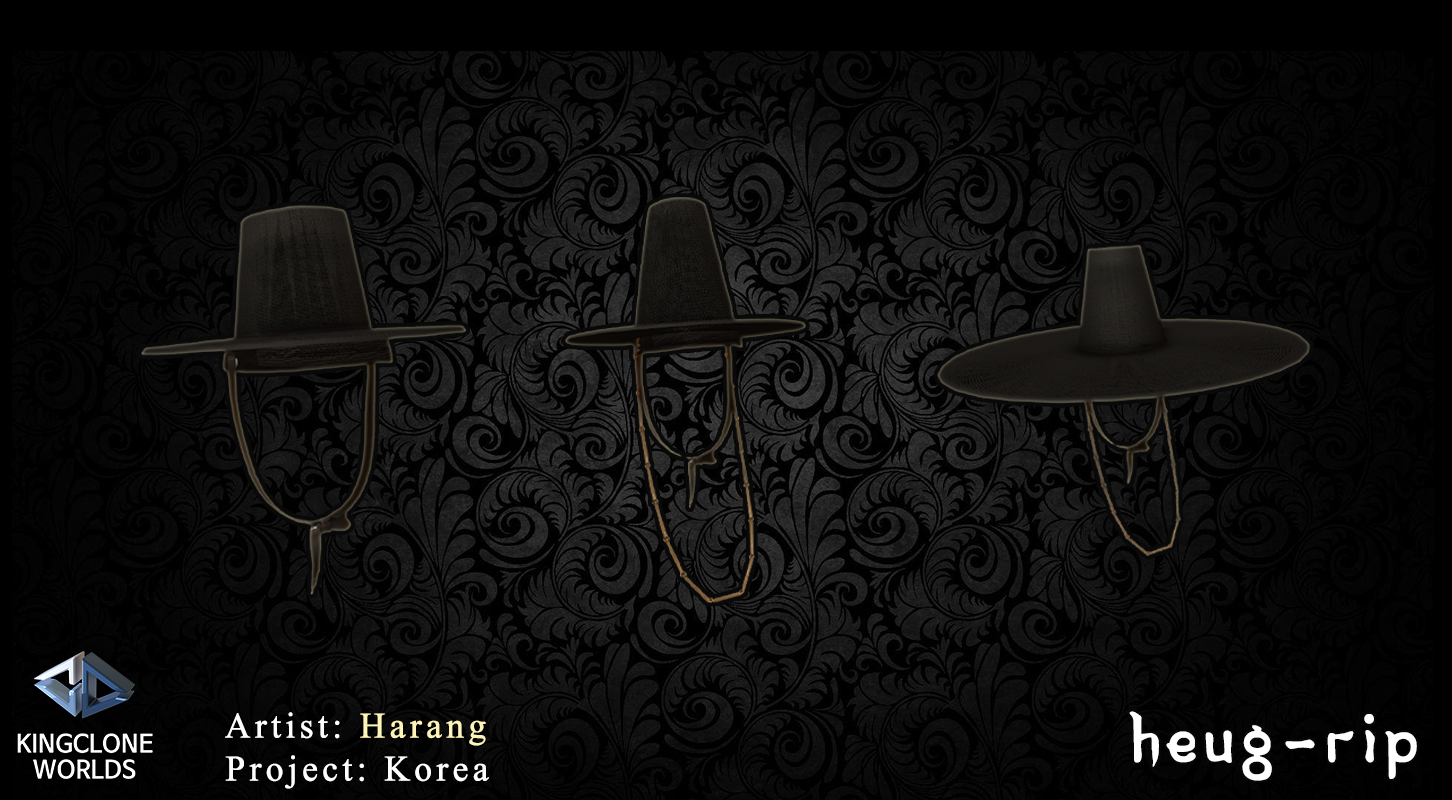
HukLyip (Heug-rip), Black Hats / Gat
HukLyip(黑笠) or HukChilLyip(黑漆笠) form of gat are made by applying black ink dozens of times and completed with a lacquer varnish.
Light is shown through, but the general complection of this form of gat is black.
- Korea Foundation for Arts and Culture, GatIl Jung ChonMo
Huklip is a form of gat worn by Chosun dynasty men, with the brim and top made of horse tail hair or splint bamboo, and finished with a wrapping of thin fabric and dark lacquer.
The hat is cylindrical form that narrows towards the top with a flat top and the brim is made with a slight curvature. Depending on the wrapping, the huklip can be subdivided into JinSaLyip, UeamYangSaLyip, UeamYangLyip, PoLyip, JukJuMoLyip, and MaMiLyip.
The huklip is a standard form of Chosun dynasty gat that resulted through developments of Parangiy(form of gat made of bamboo) and ChoLyip(form of gat made of straw) and was most widely distributed till the late Chosun dynasty. During the late Goryeo dynasty King GongMin year 16, 1367 July, Yuan dynasty traditions were abandoned and clothings were reorganized for bureaucrats and the people and a form of huklip that indicated governmental rank was worn. Later that September the Crown prince payed respects to the King and Queen wearing a gat, and this is seen as the origin of court officials wearing huklips.
- Korean Clothing Culture Dictionary (1998) / Kim YoungSook
- History of Korean Clothing Culture (1998) / Yu HeeGyung, Kim MunJa
- Korean Clothing History (1998) / Yoo SongOk
- The hand of Korea The heart of the Korean people (2000) / Yi IoRyeong
05. Cho-lip or ChoLyip
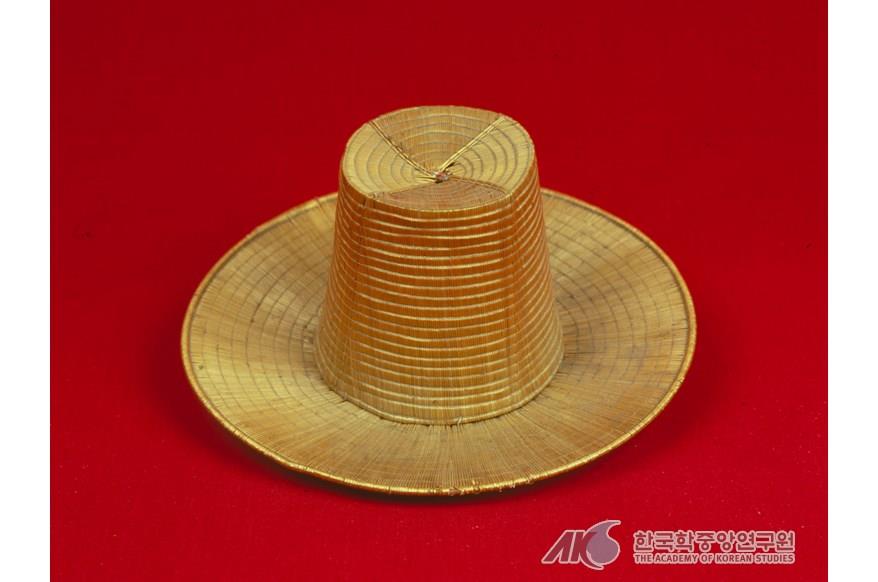
ChoLyip(Grass Hat)
ChoLyip indicates a gat made of yellowish bamboo strips for men that have done their coming-of-age ceremony(冠禮), usually around the age of 20.
In the initial records of the Chosun dynasty records show the King gifting the cholip to use outside the palace(平居), and is stated on the DaeJun(Encyclopedia of Laws on Ruling/經國大典) that the aristocracy should use 50 bamboo strips and the lower classes should use 30 bamboo strips. This slowly morphed to what men would wear after coming of age but before they were allowed to wear huklip, leading to the formation of terms such as 'cholipdongyi(cholip-boy)', to indicate men in this transitional period.
After the popularization of the huklip, cholip became established as headwear of the merchant class along with the parangi. Royal musicians(細樂手), horse guards(牽馬夫), and singers(倡優) wore cholip during banquets, and local aristocrats would
wear cholip in their everyday dressing(常服) attached with a decoration(虎鬚).
Cholip is similar to parangi, but is more advanced in material and variation and can be seen as a link between parangi and huklip. The top part is cylindrical that narrows towards the top and the brim is circular, the roof of the hat is flat.
The flat roof is akin to the huklip, but the huklip sports a downward pointing brim while the cholip shows an upwards pointing one, differentiating the 2 forms of hats.
Cholip was known to be produced in GangHwa island GyoDong, and according to DongGukYeoJiSungLam(Geography of the Eastern Nation), is also produced in DaeGu, GyungSan, and YungChun.
- GyungGukDaeJun(Encyclopedia of Laws on Ruling/經國大典)
- DongGukYeoJiSungLam(Geography of the Eastern Nation/東國輿地勝覽)
- [Study on History of Clothing of Korea], Yu HeeGyung, Ewha Womans University Press, 1975
06. SatGat

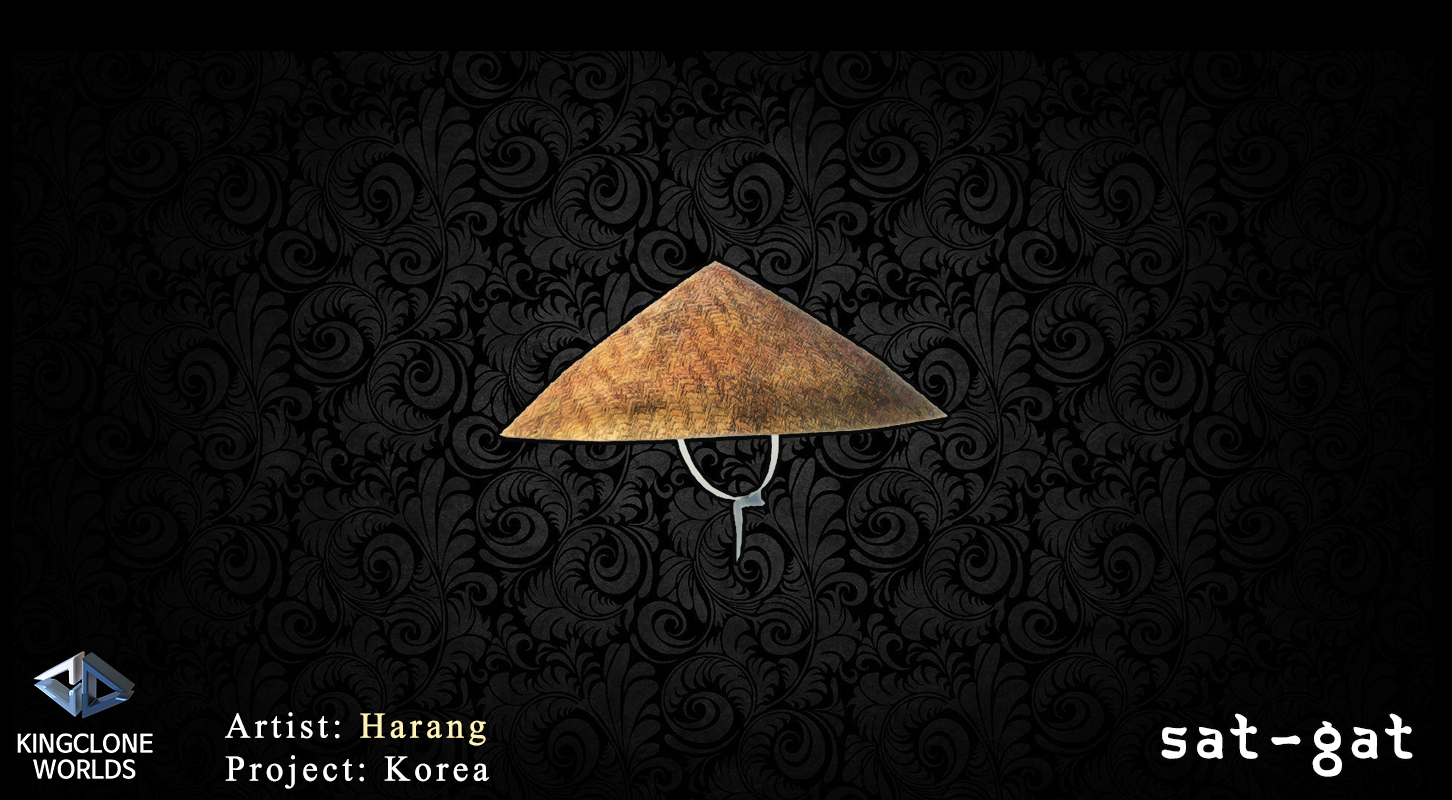
SatGat
A SatGat indicates a head covering in the form of an umbrella made of interwoven reeds or bamboo strips.
It is used to protect from the sun or rain. In Chinese it is written as NoLyip(蘆笠/Reed hat), or NongLyip(農笠/Farming hat), WooLyip(雨笠/Rain hat), and YaLyip(野笠/Wilderness hat). Depending on the material it is subdivided as NulSatGat, made of cattails, and DaeSatGat, made of bamboo strips, and SaeDaeSatGat, made of thinner bamboo strips.
Nulsatgats were used in the Gyeonggi province and Hwanghae province as head coverings for aristocrats and women, and daesatgats were used by male monks and saedaesatgats by female monks.
The form of the satgat is rather significantly primitive, considering there is no separation between the top and the brim. It's form falls under the primitive 'Square Hat form ((方笠型))'.
The satgat has been used in fully utilitarian ways since it's initial development, separating it from other types of headwear that were often used to signify social standing.
- Encyclopedia of Korean National Culture, Kang SunJae(1995)
- General Knowledge of Chosun(朝鮮常識)-Customs edition(風俗篇) Choi NamSun, 1948
삿갓과 나 (시)
The Satgat and I (Poem)
내 삿갓은
My satgat
정처 없는 빈 배
Is a wondering boat
한 번 쓰고 보니
Once I've put in on
평생 함께 떠도네
we wonder together
목동이 걸치고
the farmer wears it
송아지 몰며
and drives the calf
어부는 그저
and the fisherman
갈매기와 노닐지만
frolicks with gulls
취하면 걸어두고
I'll hang it up after a drink
꽃 구경
and enjoy the flowers
흥이 나면 벗어 들고
I'll hold it up when excited
달 구경
and enjoy the moon
속인들의 의관은
The worldly people
겉치레, 체면치레
dress in pretentiousness
비가 오나 바람 부나
But come rain and come wind
내사 아무 걱정 없네
I have no worry
김병연 (김삿갓) 1807 ~ 1863
Kim ByungYun(Kim SatGat) 1807 ~ 1863
07. Bang-lip or BangLyip
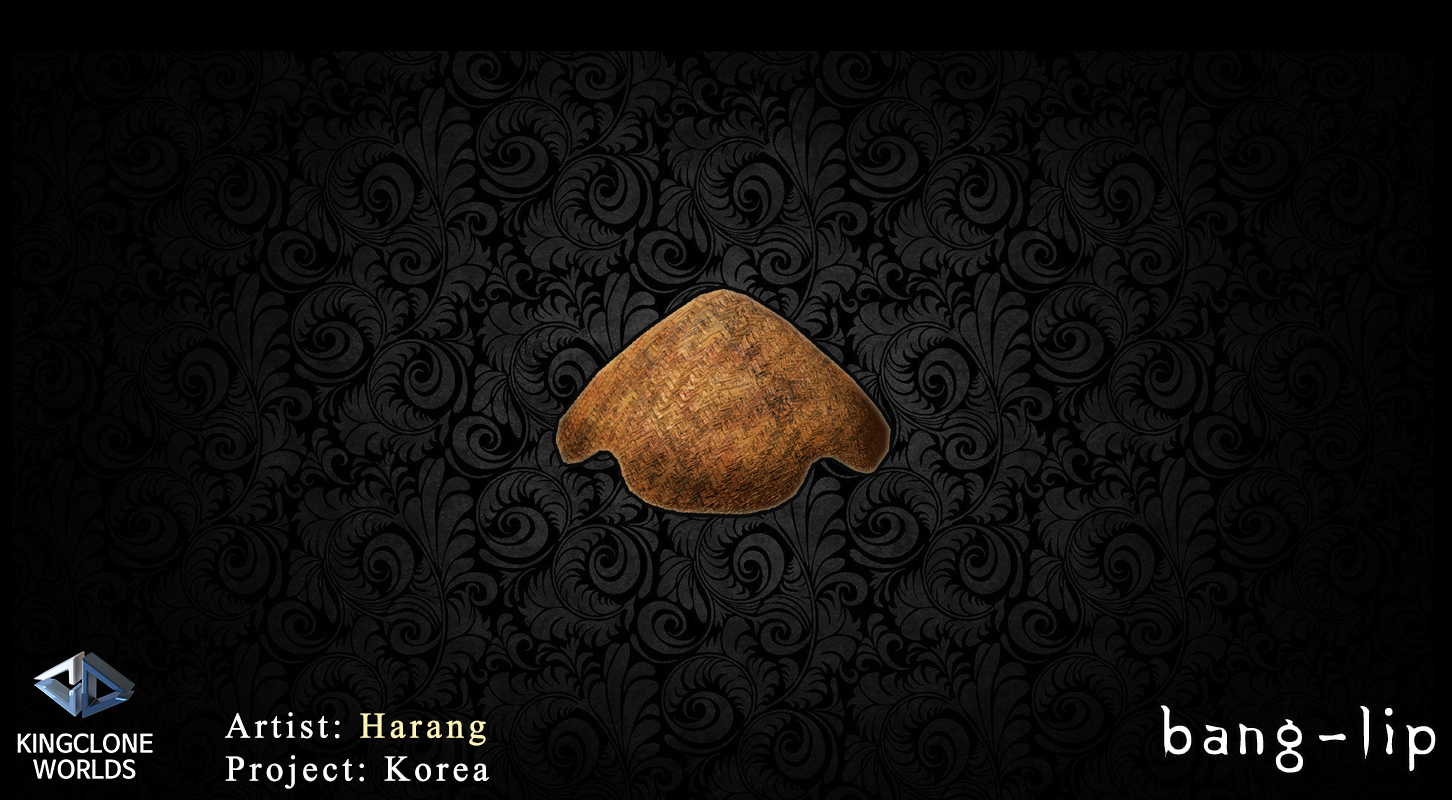
BangLyip
A BangLyip indicates an outdoors hat with a cone shaped center and petal like decorations on the 4 corners of the hat.
The banglip is a form of satgat with thin strips of bamboo on the outer layer and WangGol(a form of reed found in East Asia, Cyperus exaltatus) on the inside with four petal decorations on the brim, producing a more elaborate form of headcovering for protective purpose than the common satgat.
The banglip is also called the GulGat or the BangGat, and a BangLyip form Gat incidates both BangGat and SatGat. Here the BangGat is subdivised into HukJukBangLyip(black bamboo BangLyip) and BaekSaekBangLyip(White colored BangLyip) by color.
The use of the BangLyip depended on the period, and during the Silla and BaekJe period the people would use it commonly in everyday life leading some to call the BangLyip the Na-Jae Lyip(last syllables form Silla and BaekJe are used).
Regulations on public clothing(輿服) seen in the book GoRyeaSa(History of Goryeo/高麗史) states that on 1362, King GongMin Year 11, ranks above and including DaeUn(大言) and BanJu(班主) to wear HukChoBangLyip(Dark BangLyip). On 1375, King Wu year 0, the subordinate staff of each district were instructed to wear white banglips and ranks were differentiated between white and black, with some records showing a difference in material.
The use of the banlip changes during the Chosun dynasty. According to the ChoSunWangJoSikOk(The Annals of the Joseon Dynasty/朝鮮王朝實錄), 1416 year 16 of TaeJong, AJuns(low ranking government workers/衙前) of the central and provincial districts were instructed to wear banlips dyed with black ink(黑漆).
However records on 1425, year 7 of SaeJong writes that AJuns of GilJu, GyungSung, GyungWon, and GapSan wore PyungLyip(level or flat hats/平笠) and AJuns of BukChung and DanChun wore BangLyip, indicating depending on the location same ranks utilized different types of headwear.
1444, year 26 of SaeJong shows that the DoJulJaeSa (District Minister of the Northern Border/都節制使) returned wearing a banglip after being removed from his position indicating that the banglip likely would have been used for HyangLi(local lower governmental positions) or people who have left their position. Later in 1472, year 3 of SungJong, during YaeJo(Think tank on traditions/禮曹) it was suggested that the common clothing of PyungAn district local governmental workers were to wear HukJukBangLyip(Black Bamboo BangLyip/黑竹方笠) according to the DaeJun(Encyclopedia of Laws on Ruling/經國大典).
As indicated, we can see that before ImJinWaeRan(Japanese Invasion on the Imjin year of 1592/壬辰倭亂) the banglip was used for AJuns, people without governmental positions, and for the common cloths of HyangLis(local lower level government workers). After ImJinWaeRan it can be seen that there are no records of AJuns and other low rank government officials using the banglip, suggesting that the banglip had been mostly phased out.
However the banglip was still used for farmers and men in mourning(喪中). In pictures of the late Chosun dynasty show merchants and specific situations of women leaving the house wearing the banglip, showing that the hat was used for utilitarian reasons of blocking rain or sun rather then to indicate rank of the individual.
The relics left of banglips show that the outer layer was made of thin bamboo, and the insides were made of interwoven WangGol(a reed), with four petal form decorations on the brim. But some relics showed that struts to hold the banglip in place was found in only certain hats.
The banglip is commonly woven with bamboo and WangGol reeds but some relics show wrappings of burlap on the brim, which is to prevent the brim from becoming damaged.
The diameter of the banglip was often around the shoulder width of a man or slightly wider. Compared to this banglip worn by women were large enough to cover the torse without stabilizing struts, and in GaeSung there was a tradition of women traveling long distances wearing the aformentioned large banglips instead of common cloth coverings used in other areas of the Korean peninsula.
Clothes worn with the banglip are either DoPo(traditional male clothing of the aristocracy) or traditional clothes with wide sleeves, and in the late Chosun period worn with more simplified clothing(DuRuMaGi) or pants and a top, indicating the banglip was used as headgear mostly by men in mourning and traveling merchants.
The banglip is an outdoors hat more elaborate than a satgat, with its outer layer made of thin split bamboo, inner layer padded with wangol reed in a cone shape with the petal shaped decorations on the brim.
During the early Chosun period it was used as head coverings for low ranking officials, but went out of usage after mid Chosun, with only traveling merchants and mourners wearing the banglip. A large form of banglip that covered the face and a part of the torso was used in the GaeSung region when women left the home for long periods.
- Encyclopedia of Korean Culture, Characteristics and Significance of the BangLyip(方笠)
- 高麗史
- 朝鮮王朝實錄
- Joseon Dynasty Life and Customs in Photos(Cho PungYun, SeoMunDang, 2004)
- Study on Korea's official headwear(Kang SunJae, Seoul Women's University doctoral dissertation, 1993)
- Official headwear of the Chosun period(Onyang Folk Museum, 1988)
- Encyclopedia of Korean National Culture Book 9(Korea Institute of Spiritual Culture, 1991)
08. Galmo
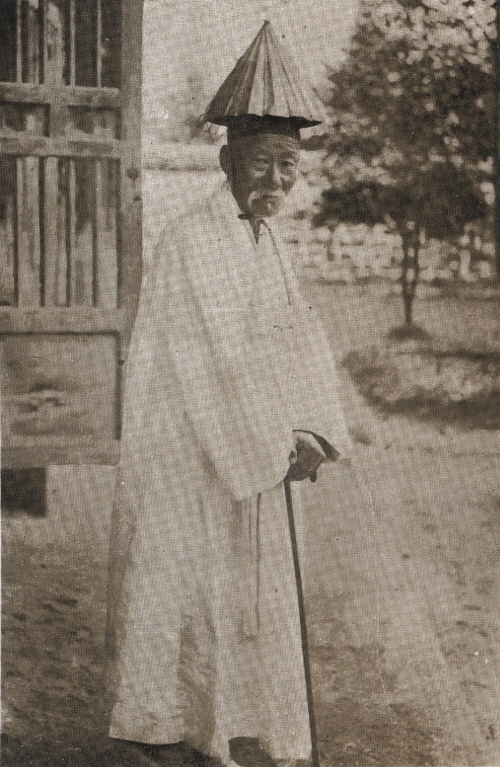

GalMo
A GalMo is a form of rainwear that was worn on top of the gat to protect from rain.
The formal term is YipMo(笠帽/Hat(Gat)'s Hat), and is sometimes called WooMo(Rain Hat/雨帽) the tip is pointed and the bottom is open in a circular form, so when open it is shaped like a cone and when folded it is shaped like a folded hand fan.
It is made of oiled paper that is either called GalMoJi(GalMo paper) or HwanJi with thin bamboo supports on the folds, and a rooster crest like decoration on the top. A string is attached on 2 points of the brim, which is placed under the chin to secure the galmo in place above the gat during rain.
It is unclear when usage began but the gat was used during the early Chosun period, but according to ChungGangSunSaegHooChungShwaeUh(Trivial words by Mr. ChungGang/淸江先生鯸鯖瑣語) written by Yi JaeShin(李濟臣) during SunJo's rule mentioning systems of headwear(笠制) during the MyungJong's rule mentions the WooMo(GalMo) indicating that the GalMo was in wide usage by the mid Chosun period.
- Encyclopedia of Korean National Culture, Kang SunJae(1997)
- ChungGangSunSaegHooChungShwaeUh(Trivial words by Mr. ChungGang/淸江先生鯸鯖瑣語)
- 『Korean Clothing History Research』(Yu HeeGyung,Ewha Womans University Press,1980)
09.GwanJae-NokChil-UhPi-GapJang-HwanDo
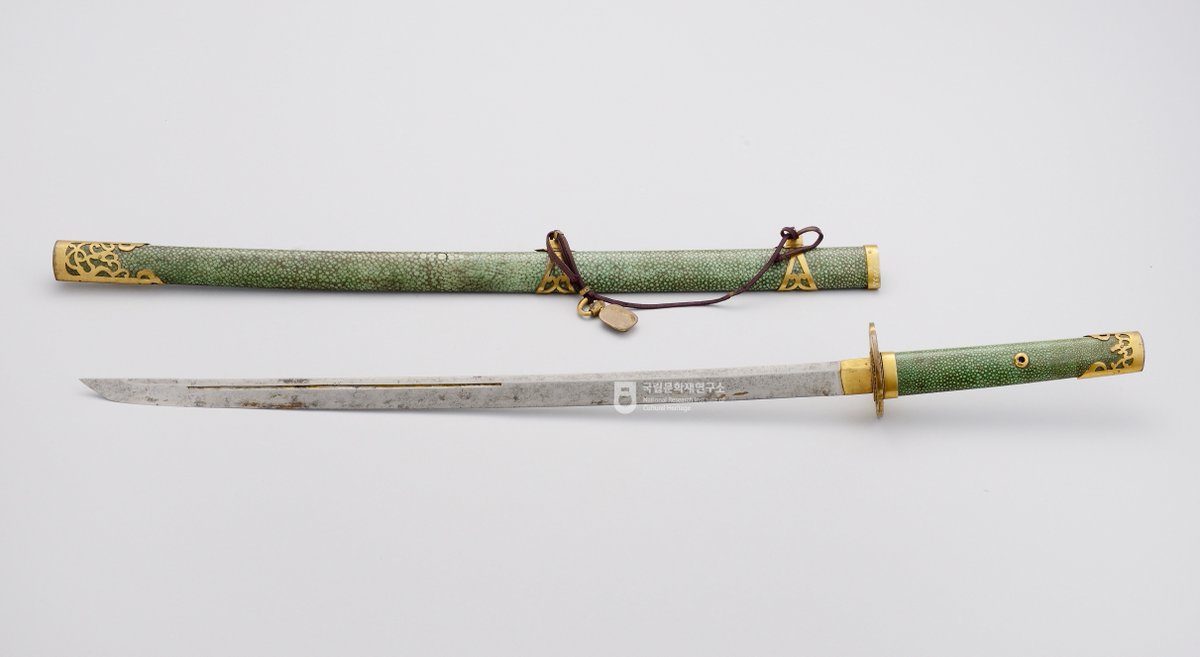
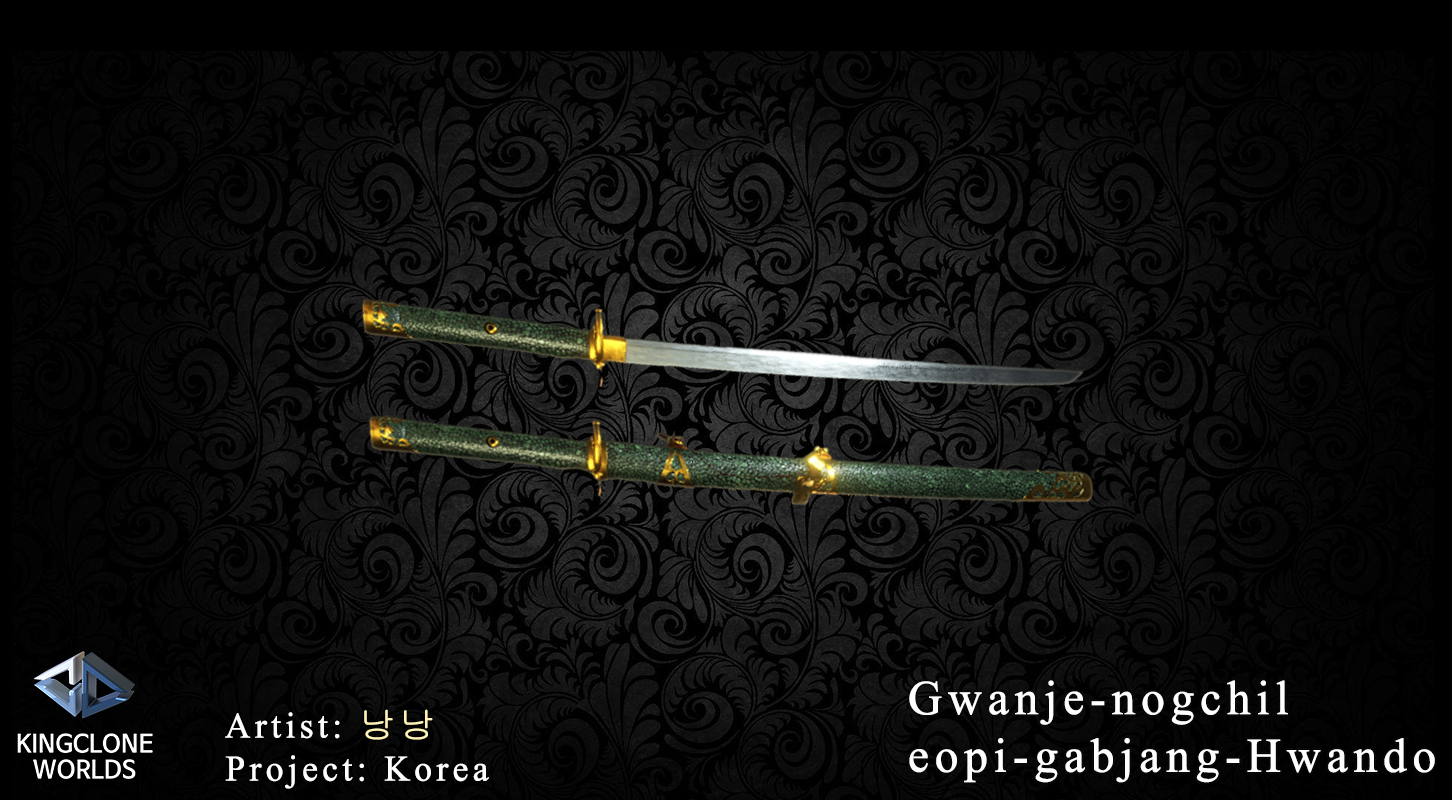
GwanJae-NokChil-UhPi-GapJang-HwanDo(Government forged Green painted Fish skin Ring Sword)
A Chosun(Joseon) era hwando currently on display in a museum in Leipzig, Germany.
A sword intended for use in a palace, it is classified as a ByulUoonGum but is not made according to the specifications of one.
The sheath and handle is wrapped in fish scales dyed in green, and decorations covering the sword are made of gilded bronze.
The handle, tip of the sheath, and upper cap are decorated with simplified forms of dragons or mythical animals as GilSangMun(symbols of luck/吉祥紋) adding further flair to the decorations.
Around 2/5 from the tip of the blade are blood drains on both sides, and a taper after the midpoint that allows ease in stabbing.
This weapon was both ceremonial and intended for combat, a craft combining practicality and ceremonial decorations intended for the royal guards of the palace.
- Cultural Heritage Administration DB
10.PyoChang
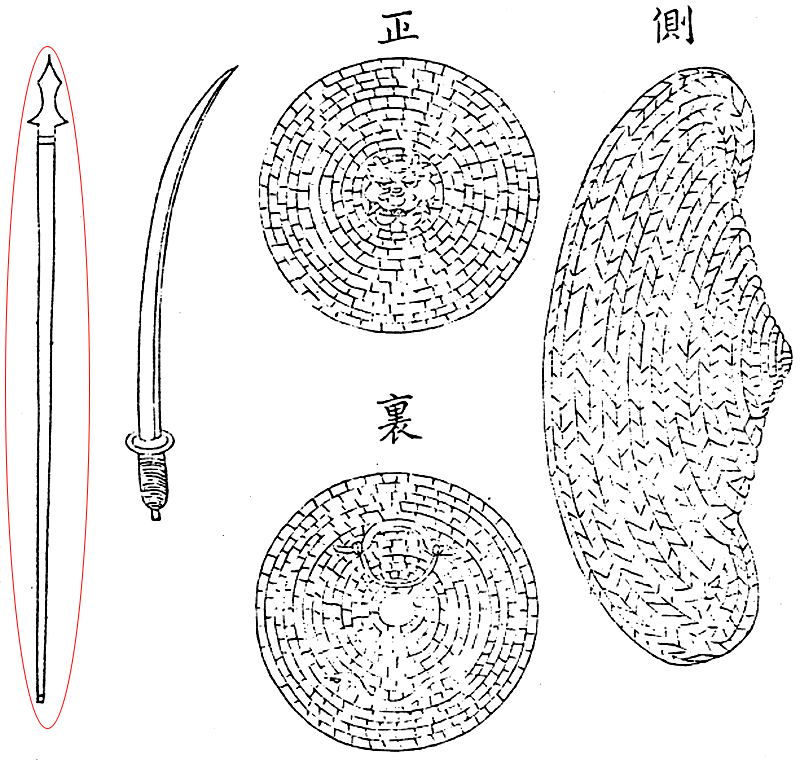
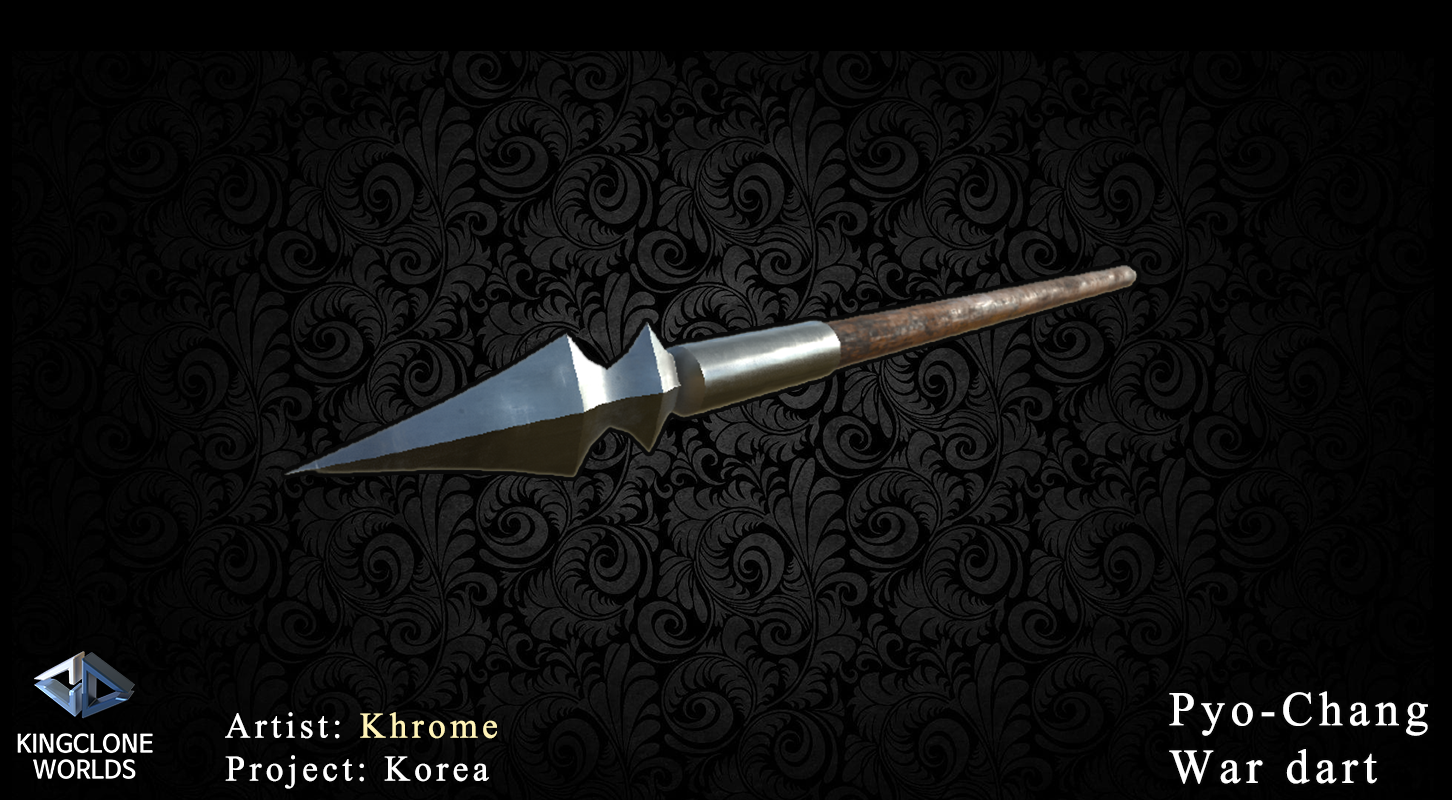
PyoChang(War dart/鏢槍)
The PyoChang is a form of short spear introduced after ImJinWaeRan(Japanese Invasion on the Imjin year of 1592/壬辰倭亂) that intended to attack the enemy from range.
The PyoChang was primarily equipped by DeungPaeSoo, or PangBaeSoo(Shield Infantry). During combat, the PangBaeSoo was equipped with a DeungPae(Rattan wood shield), a short HwanDo, and 2 PyoChangs(War darts) and would throw the darts when closing with the enemy before engaging with sword and shield. The shaft of the dart was made of hardwood or thin bamboo, with the front thicker than the back.
This makes the front, the spearhead, heavier than the thinner back improving accuracy. The iron spearhead is made with backwards pointing hooks and a indented center making it difficult to remove once embedded.
- Korea Creative Content Agency, Stories on Attempts of Overthrowing the King
11.DeungPae
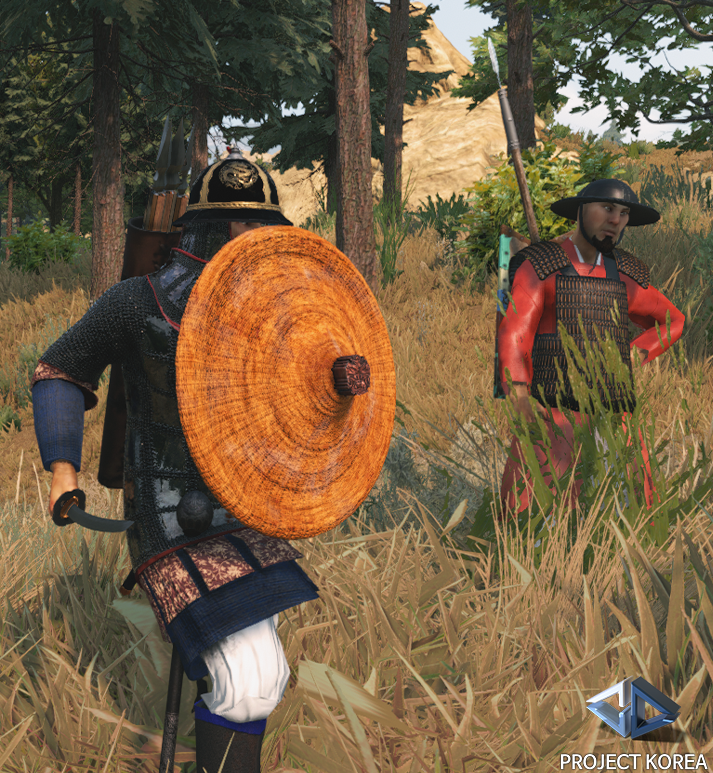
DeungPae(Rattan wood shield)
The DeungPae is a light, small circular shield originating from Southern China that was introduced to Chosun by the Ming during ImJinWaeRan. Compared to wooden shields used previously it was lighter and held up well in moisture, making it convenient for the infantry to use.
the DeungPae is made with rattan wood treated with tung oil that is wrapped in a swirl approximately 20 times, then is completed by wrapping rattan wood, bamboo fiber, or hemp rope to tighten the bindings. The center and the brim points outward and the middle curves in, making the shield more effective against arrow fire.
The outer side of the DeungPae is colored and tipped with a wooden boss, with a mulberry handle on the inner side . The diameter of the DeungPae is around 77.7 cm.
The Chosun Shield infantry was equipped with a DeungPae(Rattan wood shield), a short HwanDo, and 2 PyoChangs(War darts) and would throw the darts when closing with the enemy before engaging with sword and shield.
- Korea Creative Content Agency, Stories on Attempts of Overthrowing the King
Chuk GaeGwang(戚繼光) spoke,
"Old and thick Rattan wood according to [BonChoSupYoo(Supplements to Materia Medica/本草拾遺)], "SungDung(Sought Rattan/省藤) is found deep in the mountains of the south, it's skin is red and is as thick as a finger and can be used as rope to tie objects together", and according to JaeMinYoSul(齊民要術), "GwaDung(萪藤) is a couple Chi(about an inch/寸) thick and heavier than bamboo and can be used to replace bamboo peels to bind boats or make flooring(席)" so we use Rattan wood about a finger thick to make the structure and Rattan strips to bind it together, with the center protruding to the front and the midsection curving inward to keep arrows from hitting the hands and arms even if they penetrate the shield. The brim is pointed forward to deflect any arrows that might hit the wielder.
The handle is made of rattan, and is each placed on the upper and lower section(上下) in ring form. Each soldier has a DeungPae and a yodo(a form of hwando worn on the waist/腰刀). The sword is held in the shield hand allowing the pyochang(war dart/鏢槍) to be thrown. The thrown dart will disturb the enemy, and the solider should then hold the sword and charge. These units should be placed under NangSun(multi-spiked bamboo spear) units, without the support of nangsun units they would struggle against enemy polearm units."
He continued, "The North(北方) lacks rattan wood and use willow and leather to make similar shields, and do not always use war darts as they have fast moving horses and are armored. The current width of our DeungPaes are approximately 97.03cm(according to units used by the Ming. It is unclear what length Chuk is indicating) which is not enough to protect the whole body, so we should make it wider like the Chinese(華式). Our current method uses mulberry handles which differs from the Chinese method."
Mo WonYi(茅元儀) said,"Nowadays(近世) the Chosun people stop musket(鳥銃) fire with their shields(牌), this is to be followed."
And was written in [ByungJangGi(Memories of Soldiers and Battle/兵仗記], 'The DeungPae is light yet hard and works well in rain, making it favoured by infantrymen(步兵)."
Comprehensive Illustrated Manual of Martial arts (MuYaeDoBoTongGi)
12.Mun gwan do

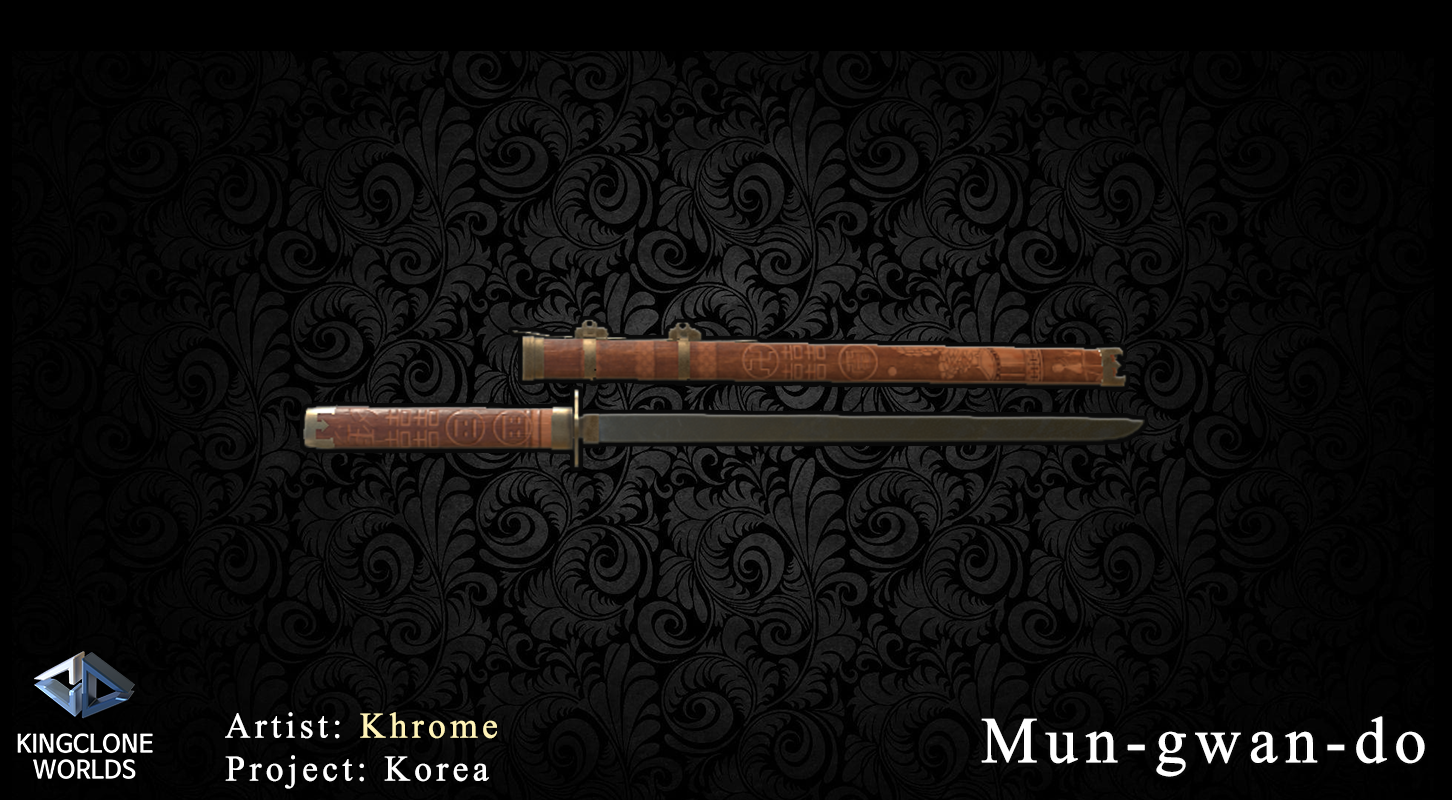
Mun-gwan-do(Sword of the Aristocrat)
It is a DanDo(Short sword), and is thought to be used personally by aristocrats and scholars.
13.Dando
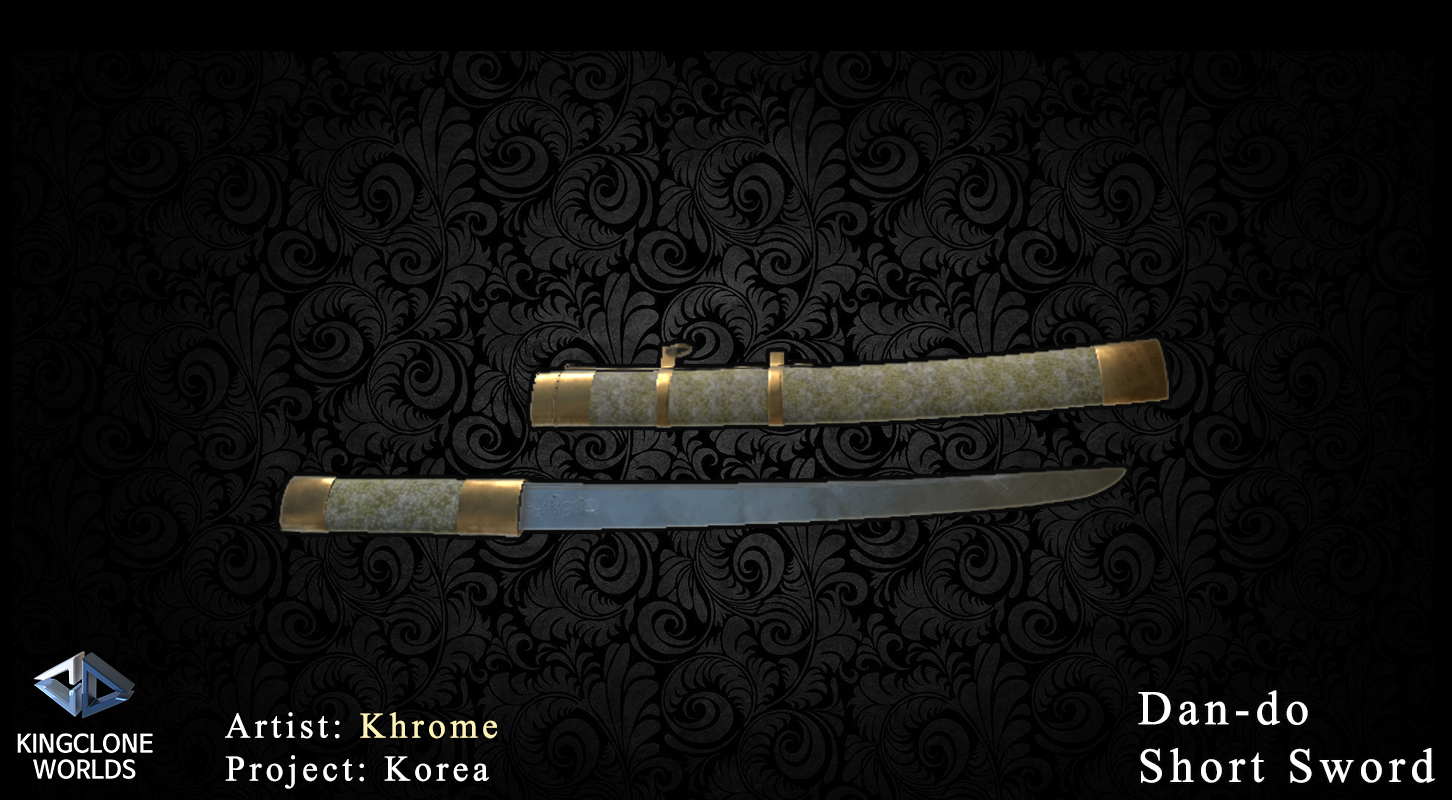
DanDo, Short Sword
A manuscript of the Chosun period was found detailing the forging of a dando, allowing insight into the concepts used when forging weapons.
According to the manuscript JoGumSik(Formula on making swords/造劒式), the Dando is to be forged deep in the mountain during the hottest 60 days of summer.
On deciding the shape and design of the dando, holistic concepts of the universe such as the circular exchange(周易), Yin Yang and Five Elements Theory(陰陽五行說), Chen Wei Theory(讖緯說), and theory on containing spiritual forces(鬼門遁甲) were used.
The blade is further decorated with the constellation Ursa Major and 2 other less visible constellation with gold wire, with 2 holes on the guard signifying the sun and moon in an attempt to channel the power of the sky in the blade.
The sheath is of transparent turtle shell(玳瑁) with gems and 7 different precious materials.
The manuscript instructed the blade to always be held under the left arm and to sharpen and shine the blade every 60 days on the day of GapJa, or on the day the blade was forged. After the sharpening the wielder was to pray to the daoist gods to retain the spiritual forces held in the blade.
These practices indicate that the Dando was used for more than just a tool or a weapon but as a way to develop spirituality and control over the power of the soul.
- KBS News, Ancient documents on how to make daggers in the Chosun Dynasty
14. Juk Chang

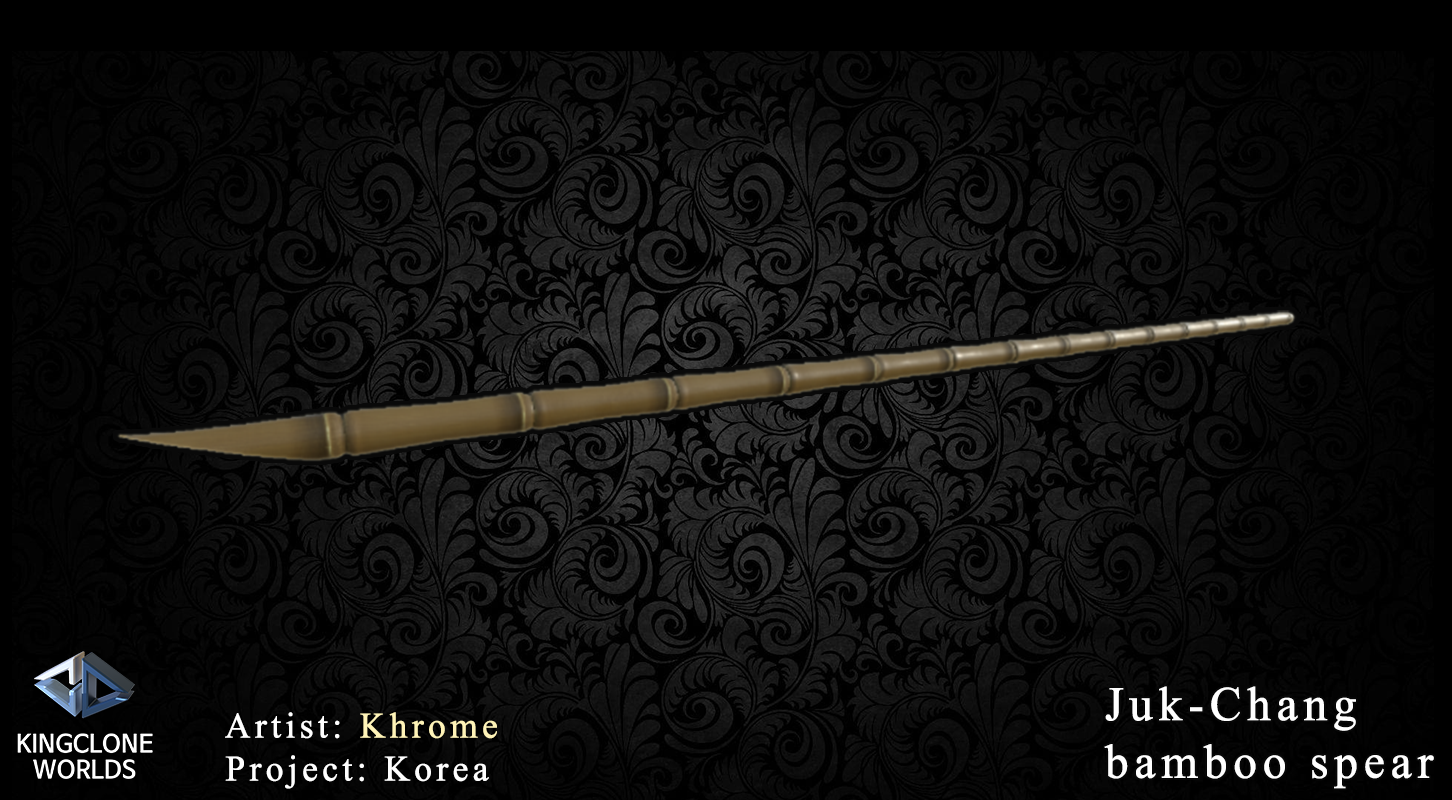
JukChang, Bamboo spear
The JukChang introduced in MuYaeDoBoTongGi(Comprehensive Illustrated Manual of Martial arts) has a shaft length of about 5~6 m with a handle length of 120~150cm. The spearhead is of simple form and is only about 12cm long. In parts other than the handle of the spear was painted in black and white.
The JukChang was made with whole bamboo, making it light and cheap and efficient to arm many men with.
Most of the JukChang of the late Chosun period was made of bamboo.
- Encyclopedia of Korean National Culture, JukChang
15.YukMoBangMangYi
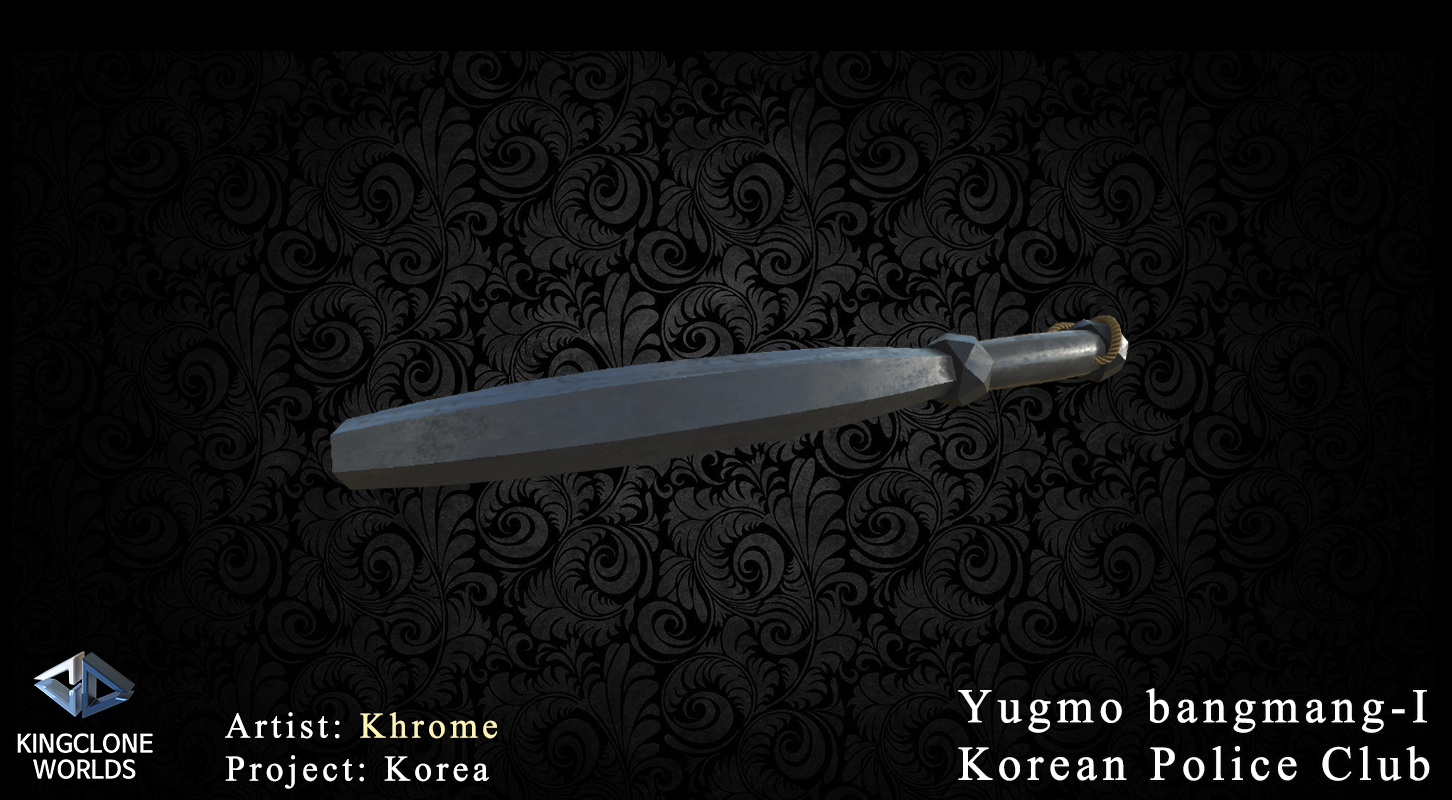
YukMoBangMangYi, Six Edged Bludgeon
Carried by PoJol(Chosun era law enforcement), the yukmobangmangyi was used for self defence or to subdue criminals, and had a signature six edges.
There were variations in shape and size depending on the purpose of the implement and the rank of the wielder.
Written by Kingclonetrooper
Translated by Jacob Powers
Thank you.
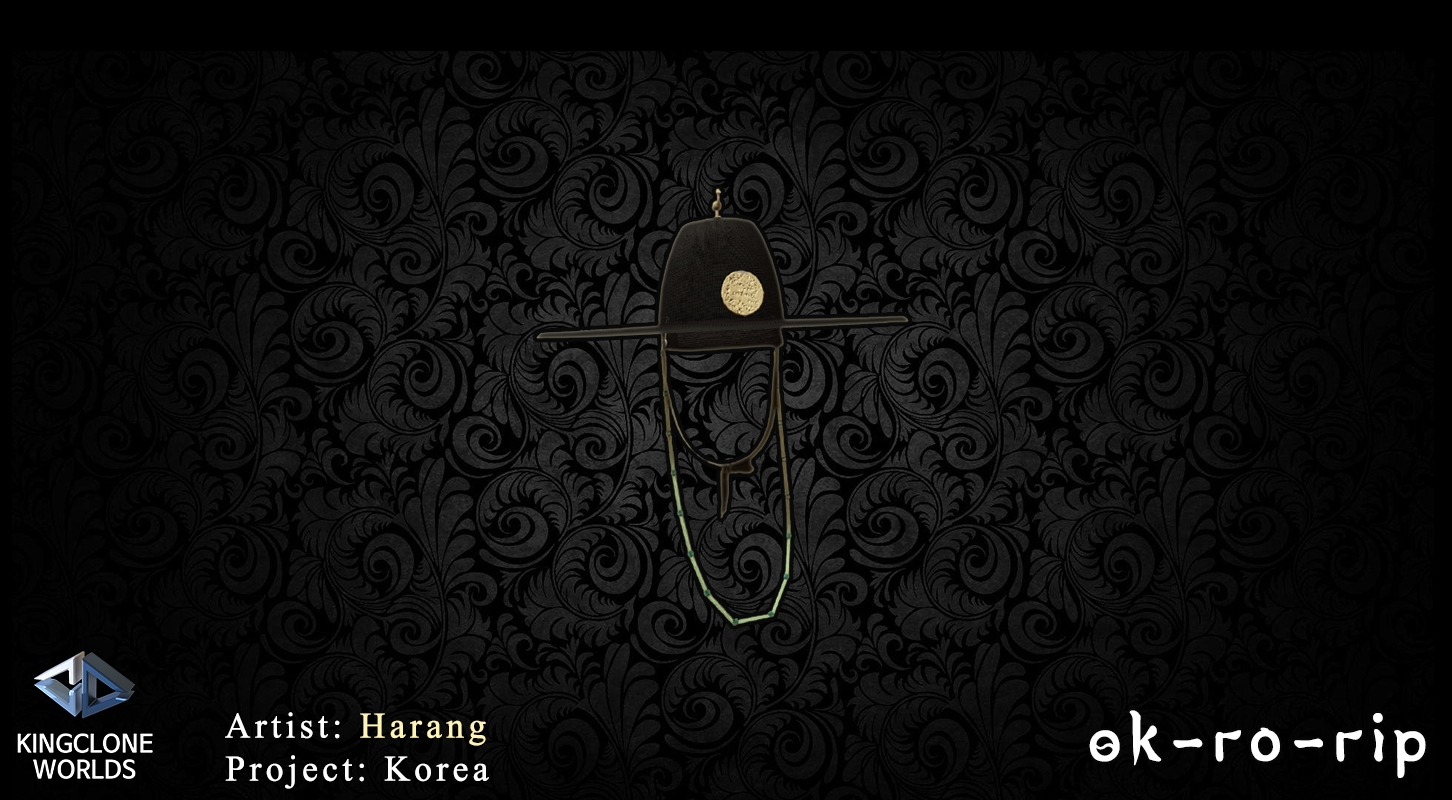
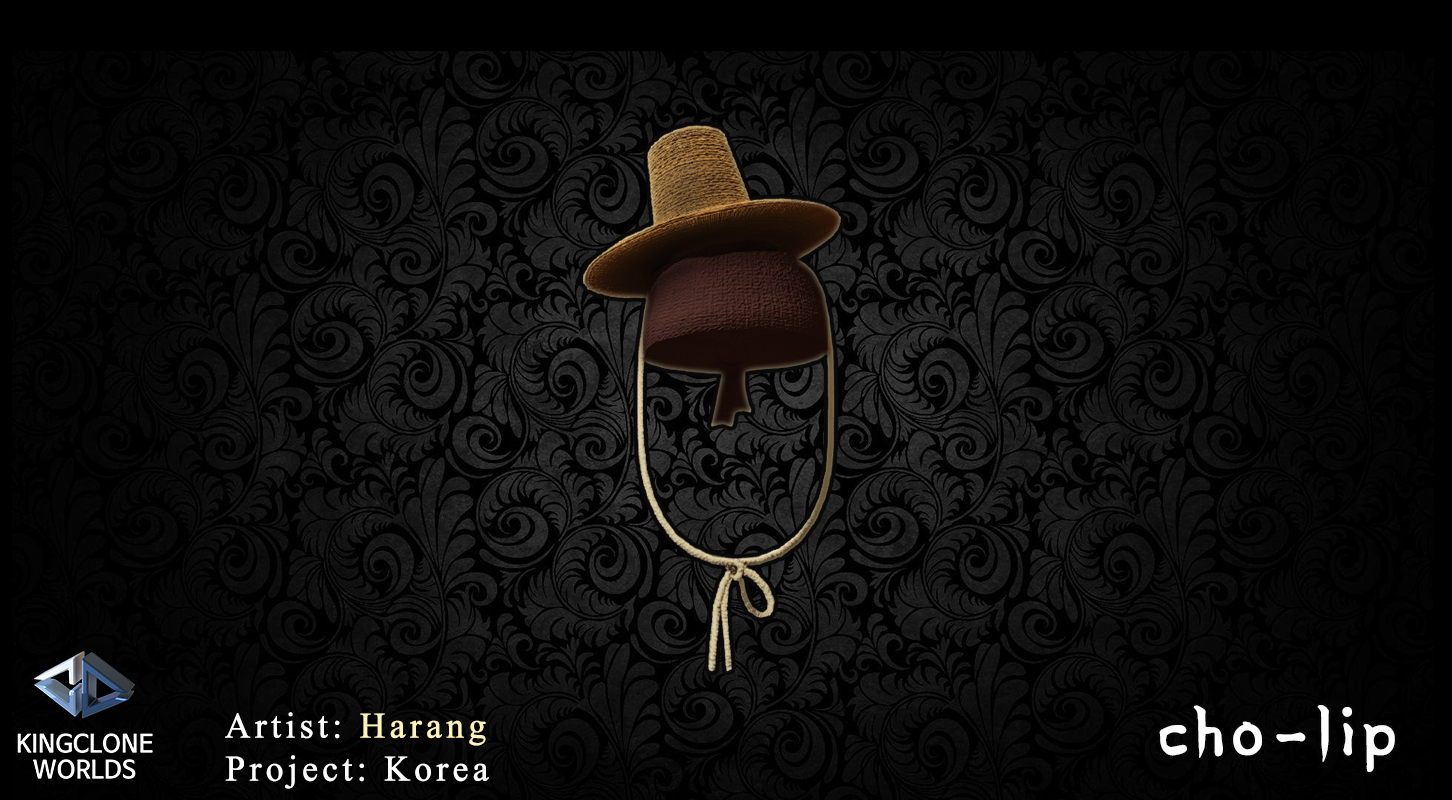
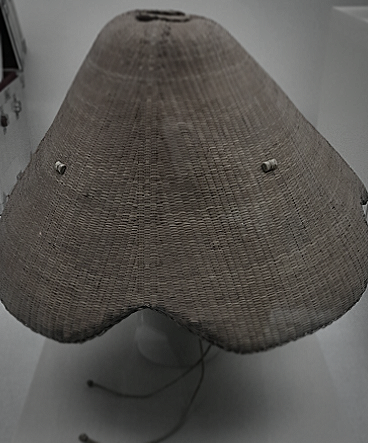
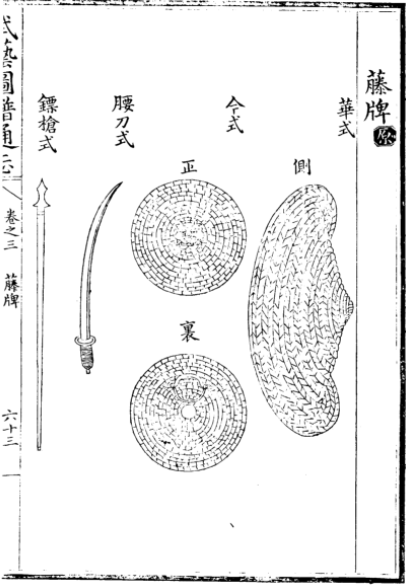

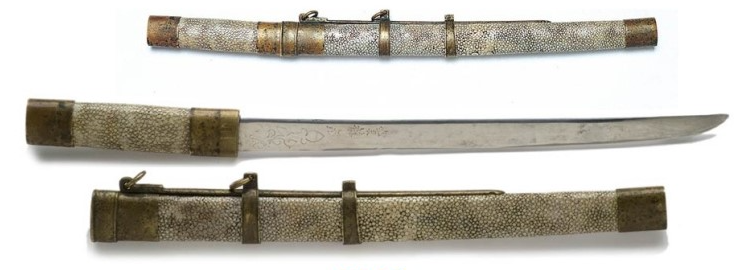



Incredible work!